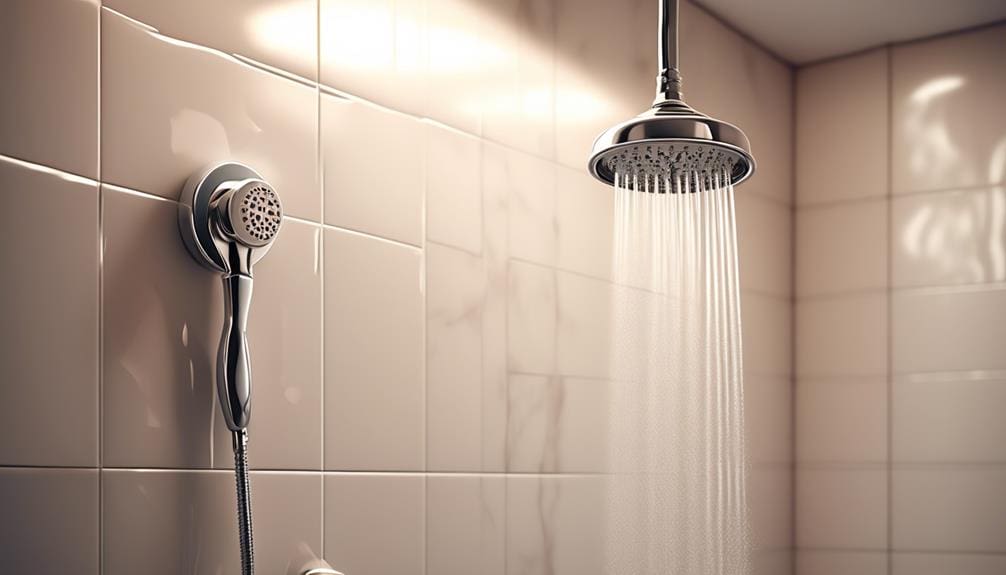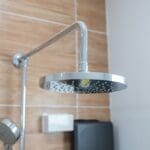If you’ve ever felt like you’d need the delicate touch of a bomb disposal expert to tighten your shower head without leaving a single scratch, you’re not alone. It’s a task that can seem deceptively simple, yet it requires a precise blend of gentleness and firmness.
You’ll need to start by gathering the right tools; think of it as assembling your toolkit for a surgical procedure on your shower. Protecting your shower head with a soft cloth is your first line of defense against unsightly scratches. But what comes next?
Loosening before tightening may sound counterintuitive, yet it’s a critical step that many overlook. By understanding and applying the correct technique, you ensure not only the longevity of your shower head but also maintain its aesthetic appeal.
Stick around to uncover the nuances of this process, and you’ll soon be equipped to handle this task with the confidence and precision it demands.
Key Takeaways
- Use an adjustable wrench with a cloth or rubber strap for a secure grip.
- Protect the shower head with silicone tape or a microfiber cloth to prevent scratches.
- Loosen the shower head counterclockwise before tightening to avoid damage.
- Apply even pressure and hand-tighten the shower head, then use a wrench if needed.
Gather Necessary Tools
Before you can tighten your shower head without causing any scratches, it’s essential to gather the right tools for the job. You’ll need an adjustable wrench, which will help you grip the shower head or the connecting nut without slipping. But here’s the key to avoiding those unsightly scratches: you should also have a piece of cloth or a rubber strap. This will act as a protective layer between your wrench and the shower head, ensuring that you can apply the necessary torque without leaving any marks.
Make sure the cloth is clean and free from any debris that could inadvertently scratch the surface. If you’re using a rubber strap, it should be flexible enough to wrap around the shower head or nut snugly but firm enough to provide a good grip.
Once you’ve got your adjustable wrench and protective layer ready, you’re all set to proceed. Remember, the goal here isn’t just to tighten the shower head but to do so while preserving its finish. With these tools in hand, you’re well on your way to achieving that, ensuring your shower head remains both functional and visually appealing.
Protect the Shower Head
To protect your shower head from scratches while tightening it, it’s crucial to use a gripping material like silicone or a microfiber cloth. These materials prevent metal-on-metal contact, significantly reducing the risk of scratching.
Before you start tightening, wrap the shower head or the tools you’re using with silicone tape, a piece of microfiber cloth, or even something as innovative as a silicone muffin cup. This not only adds grip but ensures the surface of your shower head remains unscathed.
Next, when selecting a wrench, opt for one that fits snugly over the shower valve. A proper fit is essential to avoid slipping, which could damage the shower head’s surface.
If you’re worried about the wrench making direct contact, consider placing a layer of duct tape or electrical tape on the jaws of the wrench. This acts as an added barrier against scratches.
Loosen Before Tightening
After ensuring your shower head is protected from scratches, you’ll want to start by gently loosening it by turning it counterclockwise. This initial step is crucial, especially if you’ve recently installed a Tankless Water Heater, which might’ve altered the pressure in your plumbing system, causing fittings to tighten unexpectedly. Loosening the shower head first ensures that you won’t cause any unnecessary strain or damage when tightening it back up.
Here are a few tips to effectively loosen your shower head:
- Use a wrench or pliers: If the shower head is too difficult to loosen by hand, carefully use a wrench or pliers. Wrap the tool in a cloth to avoid direct contact with the chrome finish.
- Turn counterclockwise: Remember, righty-tighty, lefty-loosey. Gently turn the shower head counterclockwise to loosen it.
- Avoid scratches: Be extra cautious not to scratch the chrome finish. Using a cloth as a buffer between your tools and the shower head can help prevent damage.
Once the shower head is loose, it’s time to tighten it by turning it clockwise. Ensure it’s secure, but be careful not to over-tighten and risk damaging the threads or your newly installed Tankless Water Heater connections.
Apply Correct Technique
How can you ensure your shower head is tightly secured without leaving behind any unsightly scratches? The key lies in applying the correct technique with precision and care. Start by applying even pressure when tightening the shower head. This simple step helps prevent any damage to the chrome surface, which is prone to scratching if handled incorrectly.
To further protect your shower head, use a cloth or rubber grip. This barrier between your tool and the chrome surface can be a game-changer, preventing scratches while you tighten. It’s also wise to steer clear of tools with sharp edges or rough surfaces. These can easily mar the finish, leaving behind evidence of your maintenance work.
When it’s time to tighten, gently hand-tighten the shower head until it feels snug. If a bit more force is needed, wrap the cloth around the shower head again and use a wrench for that final twist. Remember, it’s about securing the shower head, not proving your strength.
Test and Adjust
Once you’ve secured the shower head without leaving scratches, it’s essential to test its performance and make any necessary adjustments. Turn on the water and observe how the shower head functions. You’re looking for a steady, even flow without any drips or leaks. If everything seems in order, give yourself a pat on the back. However, if you notice any issues, don’t worry; minor adjustments can often resolve these problems.
Here are a few steps to fine-tune your shower head:
- Check for leaks: If you see water dripping from where the shower head connects to the arm, you might need to tighten it a bit more. Be gentle to avoid scratches. If that doesn’t work, consider applying some Teflon tape to ensure a watertight seal.
- Adjust the flow: Some shower heads allow you to adjust the water flow or spray pattern. Experiment with these settings to find your preferred shower experience.
- Realign the shower head: If the water spray is uneven, you might need to realign the shower head. Loosen it slightly, adjust the angle or position, and then retighten securely.
Frequently Asked Questions
How Do You Tighten Something Without Scratching It?
To tighten something without scratching it, you’ll need a snug-fitting wrench and a protective layer, like silicone or microfiber, between the tool and the object. Don’t overtighten and finish by polishing if needed.
How Do You Tighten a Shower Head?
To tighten your shower head, you’ll need a wrench that fits well. Protect the surface with a cloth, then gently tighten until there’s resistance. Don’t overdo it to avoid damaging your shower head.
How Do You Tighten Brass Without Scratching It?
To tighten brass without scratching it, you’ll need a proper wrench and a protective layer, like silicone or microfiber, between the metal. Adjust carefully, avoid overtightening, and polish with microfiber cloths afterward.





